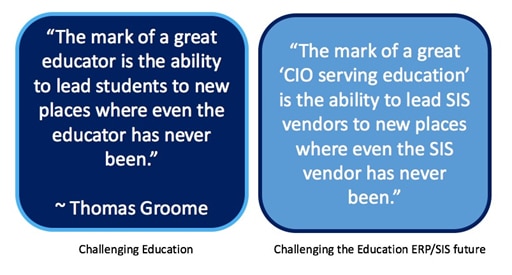When there are more questions than answers – it’s time to start leading
The years 2014 – 2016 has revealed that the ERP system landscape known as that Student Information System (SIS) has quickly changed. In many ways, the change has been 5-years in the making but finally reaching the point of transformation in 2017. The fundamental shifts creating the transformation include:
- The handful of ERP/SIS systems that have had the greatest influence and market-share have ridden a 20-25-year old design as far as the core technology can stretch – yet remain sustainable within leaner economic era.
- Most CIOs in education have shifted toward both an enterprise-wide and campus-wide collaboration model, that incorporate student and campus leader teams. Therefore, brand-name and SIS preference are no longer the likely decision.
- Few SIS system management or consulting firms understand the full need for integration of mobility and fluidity on a campus. A major SIS implementation of Workday proves this point.
- Higher education has produced more sophisticated users, comprehensive campus demands, and students who are way ahead of the ability for SIS companies to change. This was proven in recently public documents at two of the nations’ largest education systems who chose to move to the newest SIS system in the Cloud.
These fundamental shifts are in no way an exhaustive list, but quickly illuminate how leading companies such as Workday and Salesforce are quickly making inroads into higher education. Unfortunately, the above-noted shifts that are causing the transformation have generated more questions than they have answers. Yes, it is true that the best leaders ask all the right questions; but eventually, they have to make sound solutions and decisions.
After an extended period of time, when there are still more questions than good decisions, it may be time for great leaders to step forward. Having more of the same SIS/ERP system vendors only get more investment funding does not solve the problem –- rather prolongs the inevitable. Education needs true leaders who are not interested in selling software, services or appease stockholders. I am referring to leaders who know the industry, are passionate about education, and have a creative sense where the ERP/SIS future should be directed towards, and even pushed. I have chosen a two quotation comparison below to help illustrate the need for CIO’s to begin getting more engaged with taking the transformation more personal.

Considering that approximately 65% of all IT related college and university spend is related to Student Information Systems, we all have a vested interest. The vested interest is not about job security! Rather, it’s about the long-term combined good for student success and the sustainable business models for education.
Starting in 2017, it is imperative that CIOs within education become very engaged with the SIS transformational moment we all find ourselves. The decisions made during the next few years will collectively have a long-term and lastly impact. This may require its own shift in how CIOs and other leaders get engaged in defining the appropriate shift in the SIS market space.
I have been fortunate to have worked 11-years in the supercomputing industry, and 11-years for the SIS industry. The one noticeable difference between the two is that the SIS market space has very few measurements to hold its industry accountable, and/or push it into transformation. It is extremely revealing to know that the cost of education ERP/SIS systems can be collected and analyzed to help put forth a ‘truth-in-buying’ evaluation for all ERP/SIS systems. Rather, most SIS software and consulting companies are acting and performing between a state of ignorance and a state of protection – to sustain their own long-term survival.
As an example, the supercomputing industry has a standard benchmark for performance comparisons called the Linpak Benchmark, along with numerous magazines for knowledge transfer such as Inside HPC (High-Performance Computing), and HPCWire; which publish the fastest computers in the world, transformative activities, and features on the people who operate high performance computers. Unfortunately, the closest thing in the SIS market space for comparatives are ‘Sales Demos’ and ‘Non-quantitative surveys’ containing limited information of what everyone else is doing.
The one saving grace that the SIS market space has is an eight-year running report called the SIS Higher Education Market Share, Trends and Leaders Report. The annual report sponsored by The Tambellini Group is the only comprehensive report that gives leaders an unbiased view of the SIS market space. This report is a great start and a must-read for every CIO and SIS campus decision maker. However, it is really only the beginning of challenging all CIO’s to take more ownership, accountability, direction and researching the real questions we should be asking and answering. As a CIO, former 11-year SIS vendor employee, and on vendor advisory boards, I can attest that we all need to become far more engaged with the ERP/SIS market space and step up as leaders. Failure to do so may put us on another 25-year trend that we may all regret. We are not victims of the SIS market space, rather we are leaders-in-the-making, who often forget to lead when vendors are merely promoting their products and confusion within the market space.
One of the best ways to get a collective thought, decisions, input, and price points into the greater SIS community is through the application called Peertelligent by The Tambellini Group. I have recently conveyed my sentiment of seeing many educational CIOs step up as SIS leaders with Vicki Tambellini, due to her years of experience in leading industry-wide research, reports, trends, and studies.
Note: An additional article published by CIOReview includes a great challenge for all CIO’s and SIS vendors to design and create solutions that meet the needs of the student who live, learn, and work in a digital society.
Michael L. Mathews
Chief Information Officer, Oral Roberts University




